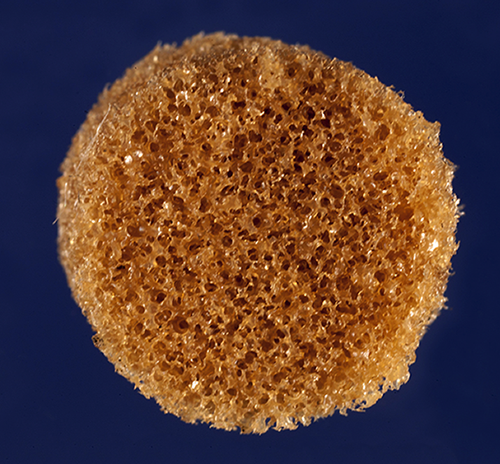New material could enable new facial reconstruction treatment

(Phys.org) —A newly developed material that molds itself to fill gaps in bone while promoting bone growth could more effectively treat defects in the facial region, says a Texas A&M University researcher who is creating the shape-shifting material.
The research by Melissa Grunlan, associate professor in the university's Department of Biomedical Engineering, is detailed in the scientific journal Acta Biomaterialia. Working with colleagues at Texas A&M and Rensselaer Polytechnic Institute, Grunlan has created a polymer foam that is malleable after treating with warm saline, allowing it to precisely fill a bone defect before hardening into a porous, sponge-like scaffold that promotes new bone formation.
The team envisions the material as a treatment for cranio-maxillofacial bone defects – gaps in bone occurring in the head, face or jaw areas. These defects, which can dramatically alter a person's appearance, can be caused by injuries, birth defects such as cleft palates or surgical procedures such as the removal of tumors, Grunlan says.
In order to repair these defects, the polymer foam developed by Grunlan her team acts as a scaffold, a temporary structure that supports the damaged area while promoting healing by allowing bone cells to migrate into the area and repair the damage tissue. Ultimately, the scaffold dissolves, leaving behind new bone tissue, she explains.
"Try as hard as we do to create artificial materials to replace damaged or diseased tissues, it is nearly impossible to match the properties of native, healthy tissue – and so the whole idea behind tissue engineering is that if we can restore native-like, healthy tissue, that will be better than any artificial replacement," Grunlan said.
"A problem," she adds, "is directing that process in these areas where there is a critical bone defect. In these types of instances where large gaps exist the body doesn't have the ability to heal the defect with new bone tissue growth; we have to help it along, and that is what our material is designed to do."
Key to Grunlan's material is its malleability after brief exposure to warm saline (140 degrees Fahrenheit), allowing surgeons to easily mold the material to fill irregularly shaped gaps in bone. Once a defect is filled, the material cools to body temperature and resumes its stiff texture, locking itself in place, she says.
This self-fitting aspect of the material gives it a significant edge over autografting, the most common treatment for these types of bone defects, Grunlan notes. Autografting involves harvesting bone from elsewhere in the body, such as the hip, and then arduously shaping it to fit the bone defect. In addition to its obvious limited availability, the bone harvested through autografting is very rigid, making it difficult to shape and resulting in a lack of contact between the graft and the surrounding tissue, Grunlan says. When this occurs, complications can arise. For example, a graft can inadvertently dissolve through a process known as graft resorption, leaving behind the defect, she says.
Another therapy involves filling the defect with bone putty, but that material can be brittle once it hardens, and it lacks the pores necessary for bone cells to move into the area and repair the tissue, Grunlan notes.
By tweaking the polymer scaffold through a chemical process that bonds individual molecular chains, Grunlan and her team overcame that issue and produced a sponge-like material with interconnected pores. They also coated the material with a bioactive substance that helps lock it into place by inducing formation of a mineral that is found in bone, she adds. The coating, Grunlan explains, help osteoblasts – the cells that produce bone – to adhere and spread throughout the polymer scaffold. Think of it as a sort of "boost" to the material's healing properties.
Thus far, the results have been promising; after only three days the coated material had grown about five times more osteoblasts than uncoated versions of the same material, Grunlan says. In addition, the osteoblasts present within the scaffold produced more of the proteins critical for new bone formation. The team plans to continue studying the material's ability to heal cranio-maxillofacial bone defects by moving testing into preclinical and clinical studies.
Journal information: Acta Biomaterialia
Provided by Texas A&M University



















